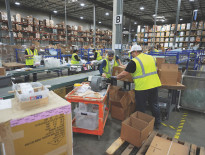BOSTON (AP) — Tariffs weren’t on the agenda of last week’s Robotics Summit, at which thousands of tech industry workers mingled with humanoid and other robot varieties and talked about how to build and sell a new generation of increasingly autonomous machines.
President Donald Trump’s new tariffs weren’t on the official agenda, at least.
Tariffs are the “No. 1 topic that we’re discussing in the hallways and at the water cooler with people that I’ve known for a long time,” said event organizer Steve Crowe, chair of the annual Robotics Summit & Expo. “I think it’s definitely top of mind, because there’s so much uncertainty about what is going to come.”
That concern is rooted in a robot’s complex anatomy of motors and actuators to move their limbs, computers to power their artificial intelligence and sensing devices to help them react to their surroundings. Sensors, semiconductors, batteries and rare earth magnets are among the array of components that may be sensitive to global trade disputes.
At the summit, some humanoid makers were looking at a potential bright side to the geopolitical shifts as American businesses look harder for domestic supplies of parts and the development of United States-based robots that can automate factories and warehouses.
“It’s added some inconveniences to our own supply chain. But it’s also opened up opportunities,” said Pras Velagapudi, chief technology officer at Oregon-based Agility Robotics. The company is starting to deploy its humanoid robot, called Digit, at a U.S. plant run by German manufacturer Schaeffler, a maker of ball bearings and other components key to the auto industry.
Al Makke, a director of engineering for Schaeffler’s chassis systems, said tariffs could push many companies toward onshoring production of a variety of items in the United States.
Most of the big industrial robots employed in the United States are used to help make cars, and are imported from countries such as Japan, Germany or South Korea. Automakers in the U.S. installed 9.6 percent more robots in their plants than a year before, according to new data from the International Federation of Robotics, a trade group.
The sole humanoid at the conference was Unitree’s G1. Marketed for $16,000 and remote-controlled by an employee standing nearby, the robot fluidly shook hands, waved back at people and walked around the show floor, but it won’t be moving totes or working in a factory anytime soon.
Its main customers outside China are academic researchers and some social media influencers, and Trump’s current tariffs totaling 145 percent on China would raise its cost to American buyers to roughly $40,000, said Tony Yang, a Unitree vice president of business development who manages its North American sales. Unitree’s strategy to rapidly develop its hardware and software is a long-term one.
“It’s still a very narrow market, but I think there’s still a huge potential market on the industry side, like for manufacturing and factory and even home use,” Yang said.









